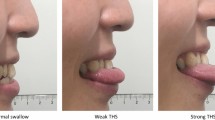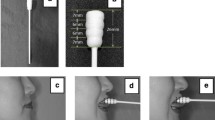Abstract
The tongue-hold maneuver is a widely used clinical technique designed to increase posterior pharyngeal wall movement in individuals with dysphagia. It is hypothesized that the tongue-hold maneuver results in increased contraction of the superior pharyngeal constrictor. However, an electromyographic study of the pharynx and tongue during the tongue-hold is still needed to understand whether and how swallow muscle activity and pressure may change with this maneuver. We tested eight healthy young participants using simultaneous intramuscular electromyography with high-resolution manometry during three task conditions including (a) saliva swallow without maneuver, (b) saliva swallow with the tongue tip at the lip, and (c) saliva swallow during the tongue-hold maneuver. We tested the hypothesis that tongue and pharyngeal muscle activity would increase during the experimental tasks, but that pharyngeal pressure would remain relatively unchanged. We found that the pre-swallow magnitude of tongue, pharyngeal constrictor, and cricopharyngeus muscle activity increased. During the swallow, the magnitude and duration of tongue and pharyngeal constrictor muscle activity each increased. However, manometric pressures and durations remained unchanged. These results suggest that increased superior pharyngeal constrictor activity may serve to maintain relatively stable pharyngeal pressures in the absence of posterior tongue movement. Thus, the tongue-hold maneuver may be a relatively simple but robust example of how the medullary swallow center is equipped to dynamically coordinate actions between tongue and pharynx. Our findings emphasize the need for combined modality swallow assessment to include high-resolution manometry and intramuscular electromyography to evaluate the potential benefit of the tongue-hold maneuver for clinical populations.





Similar content being viewed by others
References
Fujiu M, Logemann JA. Effect of a tongue-holding maneuver on posterior pharyngeal wall movement during deglutition. Am J Speech Lang Pathol. 1996;5:23–30.
Kokawa T, Saigusa H, Aino I, Matsuoka C, Nakamura T, Tanuma K, Yamashita K, Niimi S. Physiological studies of retrusive movements of the human tongue. J Voice. 2006;20:414–22. doi:10.1016/j.jvoice.2005.08.004.
Saigusa H, Yamashita K, Tanuma K, Saigusa M, Niimi S. Morphological studies for retrusive movement of the human adult tongue. Clin Anat. 2004;17:93–8. doi:10.1002/ca.10156.
Zemlin WR. Speech and hearing science: anatomy and physiology. 3rd ed. Englewood Cliffs: Prentice Hall; 1988.
Takemoto H. Morphological analyses of the human tongue musculature for three-dimensional modeling. J Speech Lang Hear Res. 2001;44:95–107.
Amri M, Car A. Projections from the medullary swallowing center to the hypoglossal motor nucleus: a neuroanatomical and electrophysiological study in sheep. Brain Res. 1988;441:119–26.
Amri M, Car A, Roman C. Axonal branching of medullary swallowing neurons projecting on the trigeminal and hypoglossal motor nuclei: demonstration by electrophysiological and fluorescent double labeling techniques. Exp Brain Res. 1990;81:384–90.
Jean A. Brainstem organization of the swallowing network. Brain Behav Evol. 1984;25:109–16.
Jean A. Control of the central swallowing program by inputs from the peripheral receptors. a review. J Auton Nerv Syst. 1984;10:225–33.
Brunner J, Ghosh S, Hoole P, Matthies M, Tiede M, Perkell J. The influence of auditory acuity on acoustic variability and the use of motor equivalence during adaptation to a perturbation. J Speech Lang Hear Res. 2011;54:727–39. doi:10.1044/1092-4388(2010/09-0256.
Perkell JS, Matthies ML, Svirsky MA, Jordan MI. Trading relations between tongue-body raising and lip rounding in production of the vowel /u/: a pilot “motor equivalence” study. J Acoust Soc Am. 1993;93:2948–61.
Fujiu M, Logemann JA, Pauloski BR. Increased postoperative posterior pharyngeal wall movement in patients with anterior oral cancer: preliminary findings and possible implications for treatment. Am J Speech Lang Pathol. 1995;4:24–30.
Lazarus C, Logemann JA, Song CW, Rademaker AW, Kahrilas PJ. Effects of voluntary maneuvers on tongue base function for swallowing. Folia Phoniatr Logop. 2002;54:171–6.
Fujiu-Kurachi M, Fujiwara S, Tamine KI, Kondo J, Minagi Y, Maeda Y, Hori K, Ono T. Tongue pressure generation during tongue-hold swallows in young healthy adults measured with different tongue positions. Dysphagia. 2014;29:17–24. doi:10.1007/s00455-013-9471-z.
Doeltgen SH, Macrae P, Huckabee ML. Pharyngeal pressure generation during tongue-hold swallows across age groups. Am J Speech Lang Pathol. 2011;20:124–30. doi:10.1044/1058-0360(2011/10-0067.
Doeltgen SH, Witte U, Gumbley F, Huckabee ML. Evaluation of manometric measures during tongue-hold swallows. Am J Speech Lang Pathol. 2009;18:65–73. doi:10.1044/1058-0360(2008/06-0061.
Hoffman MR, Mielens JD, Ciucci MR, Jones CA, Jiang JJ, McCulloch TM. High-resolution manometry of pharyngeal swallow pressure events associated with effortful swallow and the Mendelsohn maneuver. Dysphagia. 2012;27:418–26. doi:10.1007/s00455-011-9385-6.
Mielens JD, Hoffman MR, Ciucci MR, Jiang JJ, McCulloch TM. Automated analysis of pharyngeal pressure data obtained with high-resolution manometry. Dysphagia. 2011;26:3–12. doi:10.1007/s00455-010-9320-2.
Jones CA, Hammer MJ, Hoffman MR, McCulloch TM. Quantifying contributions of the cricopharyngeus to upper esophageal sphincter pressure changes by means of intramuscular electromyography and high-resolution manometry. Ann Otol Rhinol Laryngol. 2014;123:174–82. doi:10.1177/0003489414522975.
Doty RW, Bosma JF. An electromyographic analysis of reflex deglutition. J Neurophysiol. 1956;19:44–60.
Ertekin C, Pehlivan M, Aydogdu I, Ertas M, Uludag B, Celebi G, Colakoglu Z, Sagduyu A, Yuceyar N. An electrophysiological investigation of deglutition in man. Muscle Nerve. 1995;18:1177–86. doi:10.1002/mus.880181014.
Ertekin C, Aydogdu I. Electromyography of human cricopharyngeal muscle of the upper esophageal sphincter. Muscle Nerve. 2002;26:729–39. doi:10.1002/mus.10267.
Jean A. Brain stem control of swallowing: neuronal network and cellular mechanisms. Physiol Rev. 2001;81:929–69.
Amri M, Car A, Jean A. Medullary control of the pontine swallowing neurones in sheep. Exp Brain Res. 1984;55:105–10.
Jean A, Car A. Inputs to the swallowing medullary neurons from the peripheral afferent fibers and the swallowing cortical area. Brain Res. 1979;178:567–72.
Car A, Jean A, Roman C. A pontine primary relay for ascending projections of the superior laryngeal nerve. Exp Brain Res. 1975;22:197–210.
Geng Z, Hoffman MR, Jones CA, McCulloch TM, Jiang JJ. Three-dimensional analysis of pharyngeal high-resolution manometry data. Laryngoscope. 2013;123:1746–53. doi:10.1002/lary.23987.
Umeki H, Takasaki K, Enatsu K, Tanaka F, Kumagami H, Takahashi H. Effects of a tongue-holding maneuver during swallowing evaluated by high-resolution manometry. Otolaryngol Head Neck Surg. 2009;141:119–22. doi:10.1016/j.otohns.2009.01.025.
Acknowledgments
This work was supported in part by National Institutes of Health Grant DC011130, UW Department of Surgery pilot grant, and the UW Shapiro Summer Research Program. Dr. Hammer is also supported through National Institutes of Health Grants DC010900 and RR025012.
Conflict of interest
The authors declare that they have no conflict of interest.
Author information
Authors and Affiliations
Corresponding author
Rights and permissions
About this article
Cite this article
Hammer, M.J., Jones, C.A., Mielens, J.D. et al. Evaluating the Tongue-Hold Maneuver Using High-Resolution Manometry and Electromyography. Dysphagia 29, 564–570 (2014). https://doi.org/10.1007/s00455-014-9545-6
Received:
Accepted:
Published:
Issue Date:
DOI: https://doi.org/10.1007/s00455-014-9545-6




